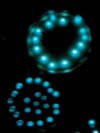About Our Bacterial Collaborators
What do we know about the bioluminescent organism used in this exhibit?

We know that it is a single-celled marine-environment bacterial isolate, probably of the Vibrio species, though we do not know its exact identity. We know that it only grows on a high-salt medium at relatively low temperatures-considerably lower than the internal temperature of the human body. Like many marine organisms, this one produces blue light through a chemical reaction.
Implications of making art with these living bacteria

The invisible becomes visible
Microorganisms live all around us (and in us) in every examined area of the Earth, yet we are rarely aware of their presence. This exhibition allowed viewers to have direct sensory contact with a microscopic organism whose origin is hidden in the depths of time and the oceans of the world.
Communication
Other Vibrio species, notably Vibrio fischeri, are known to produce light in response to the accumulation of a sufficient number of organisms. Why, in these species, the light is produced by communities rather than by single organisms is unknown, but the phenomenon raises questions about the nature of communal response and interaction.
Unpredictability
Scientists from the CBE prepared plates with a nutrient medium able to sustain these bacteria for a limited period of time; however, successful growth depends on numerous factors, not all of which we can control. How these bacteria respond to an environment created for them is inherently unpredictable.
Life cycles and the environment
When these bacteria are transferred to petri dishes, they are invisible. Within 24 hours they multiply exponentially and begin to emit a blue light. Over the course of several days, light production peaks and then begins to decline, as available nutrient is used up. This life cycle heightens our awareness of resource limitations as well as species-interdependency.
Mystery
The pale blue glow produced by these bacteria evokes an aura of the mystery of life in the remote depths of the ocean, where the vast majority of the ocean's organisms create their own light, and reminds us how little we really see and know of life on Earth.
© 2002-2003 MSU Bozeman Bioglyphs Project, a collaboration co-created by the Montana State University Bozeman School of Art, the Center for Biofilm Engineering, and billions of bioluminescent bacteria.
